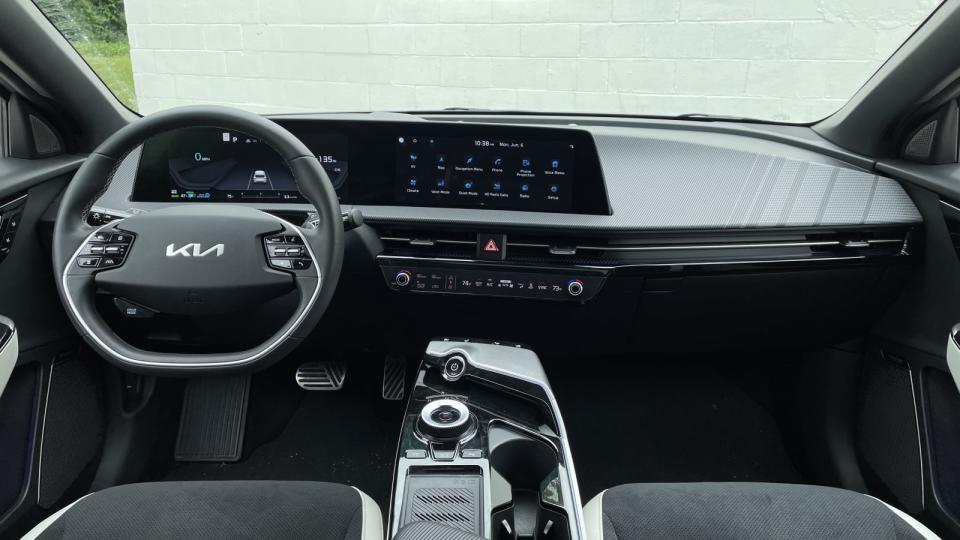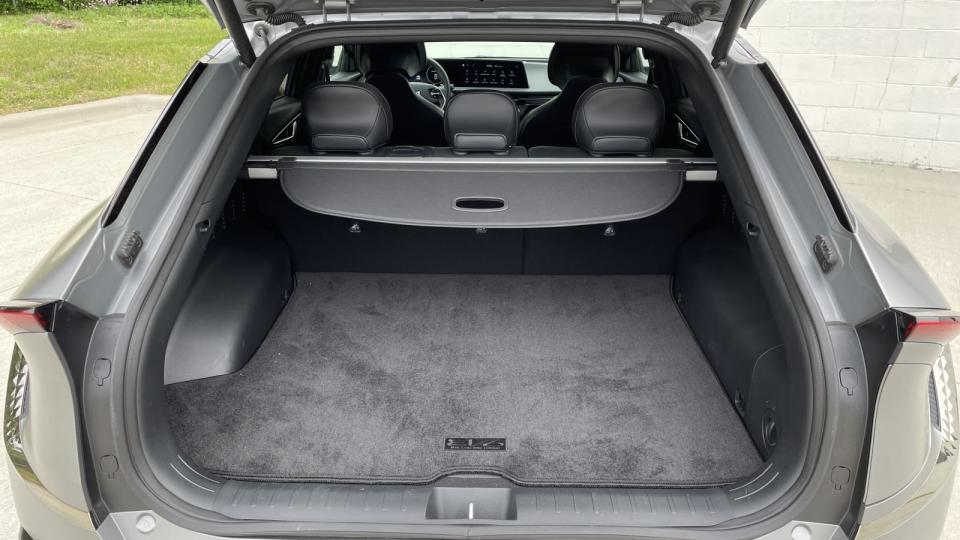2022 Kia EV6 GT-Line RWD Road Test: When rear-drive isn't the fun choice
Normally, when we talk about adding all-wheel-drive to a sporty car, it means adding weight and losing some driving fun. It also means gaining traction for quicker launches and more all-weather assurance. Either way, you can expect the exact same power coming from the engine regardless of how many wheels are driven. Electric vehicles are different. With rare exception, opting for all-wheel drive adds a second electric motor to the axle that normally does not have one as standard. That invariably adds extra performance in addition to the traction benefits of all-wheel drive. In the Kia EV6, the difference between rear-wheel drive and all-wheel drive is 95 horsepower and 188 pound-feet of torque. That's immense, equaling a 0-60-sprint time difference of 7.2 seconds with RWD and 4.6 with AWD. The price difference accounts for that, with a premium of $4,700 instead of the usual $1,500 or $2,000 in most AWD SUVs.
We've noticed, however, that dealers may not be ordering these cars with this performance angle in mind. In Detroit and Portland, Ore., for instance, every EV6 in inventory is all-wheel-drive. In Los Angeles, all but one of 25 EV6s are rear-wheel drive. That's probably pretty consistent with customer tendencies for normal, gas-powered SUVs, but it sure seems like folks in northern climates are likely paying a lot of money for extra performance they may not want, while those in southern climates are missing out on performance cause they don't realize that AWD brings benefits beyond snowy weather traction they obviously don't need.
Performance for the RWD model may be down at 225 horsepower and 258 pound-feet of torque, but range is bolstered all the way up to 310 miles, which is a 36-mile increase over the dual-motor GT-Line. That’s also normal when it comes to EVs. An identical battery pack providing power to one fewer motor is inherently going to be more efficient. The critical number for the RWD car is 117 MPGe, which is notably greater than the 105 MPGe from the dual-motor AWD version.
Punching it from a stop doesn’t yield the neck-snapping acceleration of quicker EVs, including our long-term EV6 AWD model. Instead, the RWD EV6 GT-Line pulls away from lights in a far more relaxed manner indicative of its official 7.2-second 0-60 time. That 258 pound-feet of torque is still ready in an instant once moving, but it’s never pin-you-back levels of quick.




The above said, Kia’s eco-friendly tires are still liable to squeak and slide from time to time if you get on the power through a turn. There isn’t enough excess power being sent to the rear to induce smoky oversteer, but try hard enough, and the EV6 will give you a little rotation. Its big battery pack being evenly distributed in the car’s floor means that even the slightly tall EV6 feels planted and predictable when you ask it to be unruly. Strangely enough, though, the AWD version of the EV6 is even easier to provoke oversteer from despite having a comparably sized rear motor. With traction control off, the rear end can be sent into a nice, arcing slide as you accelerate from a stop while turning either left or right. This rear-drive model is much more docile and happier to just gently apply its power to the pavement without major provocation.
It doesn’t matter which drive layout you choose when it comes to handling, as both EV6s are relatively heavy. And while the RWD one saves nearly 300 pounds of weight versus the dual-motor, it still doesn’t feel sprightly or light on its feet. The EV6, unlike sportier EVs like the BMW i4, Polestar 2 or Jaguar I-Pace, is no sports sedan alternative. Instead, it prioritizes ride comfort above corner-carving prowess. That doesn’t mean it isn’t a competent handler, but don’t expect greatness out of this chassis, even with this lighter rear-drive version.

One area where the RWD model performs identically to our long-term EV6 is in charging performance. Nobody at this price point can presently touch the E-GMP platform when it comes to charging speeds. We plugged this EV6 into a couple Electrify America stations throughout the week, and both times the charge speed quickly ramped up to and a little beyond 230 kW. As the state of charge increases, the EV6 experiences a slow, gradual drop in charge speed that you’d expect, but only falls off to be notably slow once you get beyond 90%. This results in charge stops where the EV6 goes from around 10-80% charge in under 20 minutes. Our best stop saw the EV6 go from 16-84% in only 16 minutes. This leaves you just enough time to run into Crumbl Cookies, snag a box for the week, then come back out to a car that’s ready to go (ask us how we know). Of course, this type of quick charging service is no guarantee with today’s spotty and often-malfunctioning charging networks. But when all is working as it should, the EV6 is downright peachy to charge, and should be more future proof than other EVs as those charging networks inevitably or hopefully improve.
If you want a similar charging experience in a similarly-sized vehicle, the options are limited to the Hyundai Ioniq 5 and Genesis GV60 (the EV6’s siblings), and the Tesla Model Y. Of course, the Model Y is nowhere near the EV6 when it comes to price, as its base MSRP is currently about $15,000 higher than this GT-Line model. Other competitors, including the Ford Mustang Mach-E and Volkswagen ID.4, charge significantly slower than the EV6, leaving you waiting around much longer for a similar range outcome. However, the EV6 has one big downside when it comes to charging now, and that’s the lack of an integrated navigation route planner. Kia forces you to use third-party apps to plan out road trips, which is a real bummer and an extra snag for first-time EV buyers that might benefit from a seamless system.



Another snag could be winter use of the RWD EV6 – assuming you can even find one in a northern dealership. We’ve only been able to try this version out in a hot, summer climate, so it’s tough to say how well it will handle the snow at this point. If past experience with eco-minded all-season tires is anything to go off, though, we suspect that a solid set of winter tires will be necessary. The extra range afforded by RWD is certainly tempting for winter climates, too, as low temperatures tend to be a real damper to EV range. We’ve seen total range cut by as much as 40% in the past when testing electric cars here in Michigan, so it’s understandable if you want to lessen the blow by going with the RWD model instead of the dual-motor version.
As for the details outside of powertrain performance, the RWD EV6 acts just like the AWD one. We like its interior layout and spaciousness a lot, but the Ioniq 5 could just as easily be to your preference. Regardless of how many motors it has, the GT-Line has the same technology and luxury features. That includes the comfortable and attractive two-tone “vegan” leather seats, a flat-bottom steering wheel that adds a hint of sportiness to the cabin, and features like cooled seats and a heated steering wheel. The GT-Line’s unique style elements are also common between RWD and AWD. That means glossy black exterior accents all over, wheel arch molding in body color and some slick 19-inch alloy wheels. It all makes for a much more handsome EV6 than the non-GT-Line models. Add our test car’s Steel Matte Gray paint — a GT-Line exclusive — and you’re sure to get noticed everywhere you drive.
At $53,405 as-tested, going rear-wheel-drive does represent significant savings over the AWD model, and it certainly makes sense why dealers and buyers in California and presumably other markets are choosing to save $4,700 when they don’t need winter weather traction. The added range is certainly a bonus. Unfortunately, they’re going to be missing out on an appreciable amount of extra performance – both on paper, and as we discovered, in actual driving fun. We’d have a hard time saying no to the AWD GT-Line even if our home addresses ended in CA rather than MI. We won’t be looking to trade in our long-term dual-motor EV6 for a rear-drive version any time soon.
Related video:
You Might Also Like




